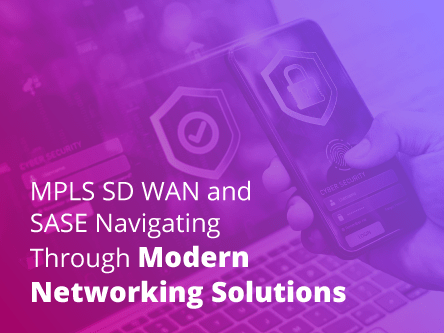MPLS IP VPN vs SD WAN
The Impact of SD WAN on Enterprise Networks
Has SD WAN technology completely replaced MPLS-based IP VPN, or is there still a use case for legacy private enterprise networks? When SD WAN first appeared, it promised a revolutionary technology. A network innovation that was cheaper, more flexible, and could replace the legacy MPLS IP VPN, giving businesses full control of their own enterprise network.
Why Are Enterprise Customers Adopting SD WAN Networks?
SD WAN networks have grown in popularity throughout the years as enterprise customers have realised the advantages they can gain by implementing the solution.
4 Benefits of SD WAN
- SD WAN networks can be easily integrated and connected to other security services such as intrusion detection systems, URL filtering and DNS services
- SD WAN is flexible and can connect new locations and users more quickly, through automation of provisioning
- SD WAN optimises the overall network performance and routing of network traffic to be more dynamic.
- SD WAN can be more cost-effective as it supports a wide variety of cheaper access networks, while MPLS sites are often added to the network via more expensive leased lines.
The emergence of SD WAN has therefore led many to question whether traditional MPLS-based IP VPN networks are still relevant today.
Does MPLS-based IP VPN Still Have a Place Today?
Despite the emergence and substantial demand for SD WAN networks, IP VPN continues to be relevant and useful in the current rapidly evolving networking landscape.
MPLS-based IP VPN remains a popular technology choice for many organisations, as it provides reliable and predictable network performance with low latency and high Quality of Service (QoS). This is essential for mission-critical applications that require consistent, high-performance connectivity between geographically dispersed sites.
4 Benefits of IP VPN
- IP VPN offers unparalleled reliability and performance with QoS for mission-critical applications such as latency-sensitive voice and video services.
- IP VPN runs over private MPLS networks, which are not vulnerable to hacks and DDoS attacks, providing greater network security for transporting sensitive data.
- IP VPN’s MPLS connections are also easier to configure, manage, and operate, without the need for additional encryption.
- IP VPN enables legacy applications and services to perform better; certain legacy applications may not be supported by SD WAN networks and may constitute to a less reliable network performance.
As part of their global enterprise network strategy, some clients have opted to use a combination of SD WAN and IP VPN. While adopting the newer SD WAN technology, they also continue to rely on IP VPN for access to centrally hosted (legacy) applications, which may still perform better over the traditional MPLS-based technology.
The decision to use either IP VPN, SD WAN, or even a combination of both depends on the individual customer’s network requirements and use cases. Numerous factors must be taken into consideration to determine the appropriate technology for the customer’s enterprise network. This includes network performance, transport, distribution, cloud accessibility, security, and network expenses.
SD WAN vs. MPLS IP VPN: Which Is A Better Fit?
Service providers need to evaluate the functionality of both options and assess if they have the necessary capabilities to adopt and manage SD WAN.
Does the enterprise have applications running on private IT infrastructure? Are these applications hosted in their own colocation data centre or virtual private cloud infrastructure? If the answer to these questions is yes, then IP VPN can fulfil their needs.
If the enterprise is mostly consuming Software as a Service (SaaS) applications over the internet and has the skills to make changes to improve the applications’ performance, SD WAN has the clear advantage over IP VPN.
SD WAN vs MPLS IP VPN: Which Offers Higher Security?
IP VPN runs over private connections. This creates a lower attack surface for bad actors to try to break-in to. While they may still require internet access for their users, it can be delivered at a single site or dual sites for resilience, and firewalls would only be required at those sites.
Customers using SD WAN and a local breakout would require security at all sites as the attack surface is larger. SD WAN seamlessly integrates with Secure Service Edge (SSE), resulting in the creation of a highly integrated Secure Access Service Edge (SASE). In contrast, MPLS is less flexible in creating SASE and is also more complex to provision. The answer to whether IP VPN or SD WAN offers higher security therefore depends on the use cases for the network, and if the enterprise IT-users are relying heavily on distributed SaaS and cloud applications.
SD WAN vs MPLS IP VPN: Which Offers Better Performance?
Performance is impacted by the public internet in the scenario where a customer has SD WAN with the internet as the underlay network. This leaves them with less capabilities to deal with the performance.
Often, enterprise customers still require an MPLS based underlay to support critical applications. Many applications work much better on the predictable and deterministic MPLS underlay, because QoS can be controlled and guaranteed.
Although SD WAN provides many techniques for improving application performance over the Internet which is a contended service, MPLS typically uses private uncontended access and an uncontended core network.
Mesh routing of IP VPN, guaranteed QoS, and the absence of hair pinning through an enterprise location work together to minimize latency, jitter, and packet loss, resulting in improved network performance.
4 Features of IP VPN for An Improved Application Performance
IP VPN offers several features that improves application performance:
- Mesh routing and uncontended bandwidth to reduce latency, and guaranteed Quality of Service.
- Highly resilience options for access circuits.
- Highly resilient core networks.
- Access through Ethernet and MPLS NNIs to increase reach with guaranteed bandwidth.
SD WAN vs MPLS IP VPN: Which Is More Cost Efficient?
Enterprise customers consuming Infrastructure as a Service (IaaS) from multiple cloud service providers will need the applications in different clouds to communicate with each other. They will also need to communicate with the other enterprise locations, either via internet or private access.
In this scenario, SD WAN can be cost-efficient for the enterprise as it can use all available types of connectivity access points such as fixed internet, mobile internet and other available connections including MPLS.
Although a dedicated IP VPN network can be more expensive to establish initially due to the use of dedicated connections, it can be a more cost-efficient network to operate compared to SD WAN. This is because IP VPN is managed and operated centrally, by the service provider after implementation, resulting in lower operational costs for the enterprise.
Using IP VPN as the underlay to communicate between cloud providers over private cloud connections will enable significant savings on cloud egress costs, plus the costs of securing internet connectivity to protect the data traveling over the internet.
Conclusion: IP VPN Remains Beneficial for Enterprise Networks
Is IP VPN still the best enterprise network for organisations today? In many instances, traditional IP VPNs continue to be the preferred choice, providing superior performance, enhanced security and often at a lower cost. IP VPN networks offer unparalleled reliability, security, and performance for business-critical applications, including voice, video and on-premise IT services. Consequently, many businesses opt to adopt a hybrid enterprise IT network approach, utilising both IP VPN and SD WAN networks in tandem.







